#Etienne Marcel
Explore tagged Tumblr posts
Text
youtube
Camille Saint-Saëns (1835-1921) - Etienne Marcel: Récit et air de Béatrix "Ah ! Laissez-moi, ma mère !" ·
Véronique Gens · Münchner Rundfunkorchester · Hervé Niquet
4 notes
·
View notes
Text










Children of Paradise (Les Enfants du Paradis) (1945) Marcel Carné
December 28th 2024
#children of paradise#Les Enfants du Paradis#1945#marcel carné#arletty#Jean-Louis Barrault#pierre brasseur#Marcel Herrand#maría casares#Louis Salou#Pierre Renoir#Jane Marken#Marcel Pérès#Etienne Decroux
12 notes
·
View notes
Text
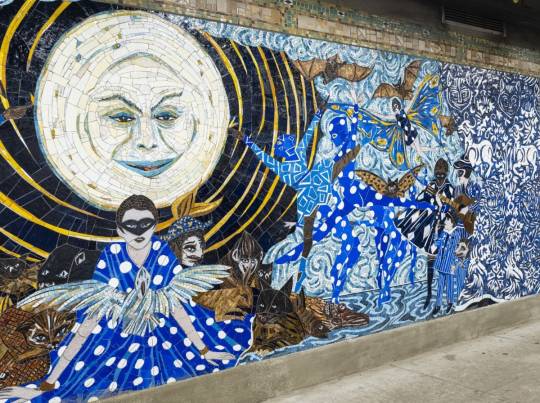
Art by Marcel Dzama (Photo: Kris Graves)
How New York City’s Subway Stations Have Transformed Into an Underground Art Gallery
400 permanent artworks to adorn the stations. A celebration of these ground-breaking projects, Contemporary Art Underground: New York MTA Arts & Design highlights more than 100 artworks completed between 2015 and 2023 that embody the spirit, vibrancy, and diversity of New York.

Art by Kiki Smith (Photo: Anthony Verde)

Art by Jeffrey Gibson (Photo: Etienne Frossard)

Art by Damien Davis (Photo: Etienne Frossard)
#marcel dzama#artist#art#kris graves#photographer#new york city#subway stations#street art#underground art gallery#artworks#kiki smith#anthony verde#jeffrey gibson#etienne frossard#damien davis
6 notes
·
View notes
Text
"Marcel Marceau: Embajador de Buena Voluntad y maestro de la pantomima"

View On WordPress
#1. Marcel Marceau#10. Premios y reconocimientos de Marcel Marceau#11. Marcel Marceau en el cine#12. Influencia de Marcel Marceau en el mundo del arte#2. Pantomima contemporánea#3. Arte del silencio#4. Mimo francés#5. Buster Keaton#6. Charles Chaplin#7. Etienne Decroux#8. Carrera artística de Marcel Marceau#9. Legado de Marcel Marceau
0 notes
Text
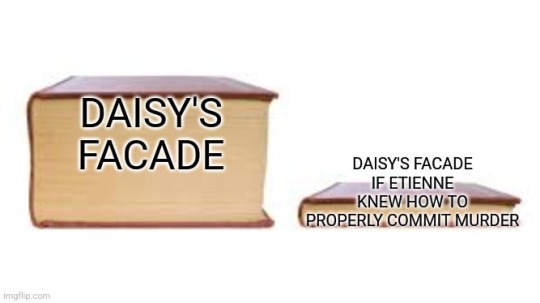



This story is holding itself together with one (1) staple
#my writing#ish#so breakdown of each one:#if etienne acrually killed blanche a lot of of problems honestly couldve been solved!!#sure blanche's sister wouldve been mad and also gone off on etienne#but she'd probably be pleasantly surprised to discover her sister's best friend is alive#bc marcel was convicted of blowing the kingdom up not delphine#meaning cara couldnt hold that over delphine's head#if briar (referred to as valentine in the book since lucas calls her val) pulled rank#then cara wouldve been arrested so fast#like plot who#but noooooooo briar had to think about her public image as an enemy princess who became the kingdom's queen like 2 hours ago /lh#and instead searched for tangible proof besides 'my magic said so'#if delphine had a gun and car... feels pretty self explanatory#like you could lack all context and probably understand that one#and ofc#if cara just asked lucas to be heir... he wouldve said yes so darn fast#the whole crux of the problem is that a) lucas doesnt spend enough time around cara to know why she hates him#and b) cara immediately assumed that lucas wants to be duke#when in truth lucas to quote#'doesnt need a third job'#and eagerly wouldve allowed cara to become duchess if she didnt#i dont know#tried to assassinate him at his friend and cousin's coronation#but yeah. fun stuff
1 note
·
View note
Text

L'Art et la mode, no. 14, 8 avril 1893, Paris. Toilette Loïe Fuller. Blouse et jupe en mousseline ou tissu ombré plissé accordéon. Empiècement et bretelles de velours glacé. Garnitures et Passementeries de la Maison Coiquil, Taravel et Gay, 23, rue Etienne-Marcel. Parfums aux Violettes du Czar de Le Legrand, 11, Place de la Madeleine. Paris. Bibliothèque nationale de France
#L'Art et la mode#19th century#1890s#1893#on this day#April 8#periodical#fashion#fashion plate#color#bibliothèque nationale de france#dress#gigot#Loïe Fuller#Modèles de chez#Maison Coiquil Taravel et Gay#Marie de Solar#april color plates#fav april
127 notes
·
View notes
Note
Hii! I don't know if this counts as a ‘name like’ request, but we have two requests !!! (Either or both would be amazing!!)
01 : Names like the words “Precipice,” “Lament,” and “Volition.” Out of names, I wish for them to be most similar to Antoine and/or Laurent.
02 : Names like the word “Ribbon” and the names “Irene,” “Marie,” and “Mizuki.”
Thank you in advance!!

I couldnt find much so I just did as many as I could! sorry about that!

ANTOINE / ANTOINETTE��� adam. adeline. adrian. aiden. alexander. alexandre. alexis. alfonso. amandine. amelia. anastasia. andeana. andoni. andre. anna. anne. annette. anthony. antione. antoan. antoine. antoinette. anton. antoni. antonia. antonie. antonin. antonina. antonio. antoniy. antoniya. antony. antoon. antwan. antwon. arabella. arthur. auguste. augustin. augustina. aurora. belinda. benjamin. caleb. camille. carlotta. catherine. cecelia. charles. charlie. charlotte. clarisse. claude. claudette. clementine. clover. clémence. collette. damian. diane. dolores. dominique. dorothee. eleanor. elie. elisha. elizabeth. eloise. emile. emma. esme. esteban. ethan. ezra. fernando. francis. franco. françois. gabriel. gaston. genevieve. giacomo. giuseppe. grace. grand. guinevere. gwendoline. gwendolyn. helga. henri. henry. ishmael. jackie. jacob. james. janette. jean. jeanette. joachim. joffy. johannes. john. jordan. joseph. josephine. juan. jules. kal. khaliah. laurien. letitia. liam. louis. louise-marguerite. louise. lucas. lucinda. madeleine. makayla. margaret. marguerite. maria. marie. marion. mary. maxime. megara. michael. myara. nell. nicolette. noah. noel. olga. oliver. olivier. paolo. peyton. philippe. phyllis. pierre. pietro. portia. ramon. raul. revence. rosanna. rosemarie. roxane. salvador. santiago. scarlett. sebastian. silvia. sonia. terence. ulrich. veda. vincent. violet. william. yvonne. étienne.
AND MORE︰ ⭐ 🐶 🪐

LAURENT︰ agustin. alain. alexander. alliance. alphonse. amelie. anais. antoine. armand. arnaud. arturo. asher. astrid. atticus. auguste. charlotte. christophe. constantine. corinne. cécile. delphine. dominique. emil. emile. esme. etienne. evangeline. ezra. fidelia. françois. gabriel. gareth. genevieve. gilles. guillaume. hadrian. helene. henri. hrh. hugo. ignacio. isabella. isabelle. isadore. jean. jude. lawrence. leo. leonidas. levi. lorand. lorant. lorenzo. lorinda. lucien. ludovic. marcel. marcello. marcellus. marie. nathalie. nathaniel. octavian. oliver. olivier. philippe. pierre. raoul. remi. rosaire. sandrine. sebastian. shey. stephane. sylvie. sébastien. thaddaeus. theo. théophile. valentin. vincent. vincenzo. virginie. visa.
AND MORE︰ ⭐ 🐶

IRENE︰ ada. adelaide. alex. alexander. alice. alix. amelia. antonia. aron. augusta. benjamin. blaine. braden. braelyn. brayden. charlie. charlotte. clara. claudia. constance. cora. cornelia. cynthia. dane. david. diana. dorothy. drake. dwayne. edith. edward. elizabeth. eloise. erin. esther. evelyn. florence. francesca. francis. gabriel. genevieve. george. georgiana. grace. graysen. grey. guadalupe. hazel. helen. helena. henry. iorwen. iram. irem. iren. irena. irina. iris. irma. irwin. iryna. isaac. james. jane. jean. jessie. john. joseph. juan. kane. lane. layne. leslie. lucinda. magdalena. margaret. maria. marian. marie. marion. mary. michael. miguel. miriam. oliver. olivia. owen. pablo. patricia. priscilla. rayna. rayne. reina. rene. rey. robert. rosalind. sylvia. tabitha. theodora. veronica. victoria. william. willie.
AND MORE︰ ⭐ 🐶

MARIE︰ alexander. alexandra. alice. alix. amanda. amelia. amy. angela. ann. anna. anne. auguste. benjamin. bethany. carolina. catherine. charles. charlie. charlotte. christine. corinne. elisabeth. elizabeth. ellen. emery. emile. emma. emory. ethan. francis. franz. friedrich. gabrielle. georg. grace. henry. isabella. jacqueline. james. jan. jean. joanna. john. joseph. jules. kareem. katharina. kathleen. laura. lee. leopold. liam. louis. louise. lynn. maeve. mahari. maree. margaret. mari. maria. mario. mary. maximilian. mayer. mayur. mehera. meir. meora. merari. michael. miner. minoru. mira. mirah. mirai. miranda. mirari. mireia. miri. mirra. mirri. moira. monroe. mora. more. morey. moriah. morrow. moyer. murray. myra. nicole. noel. oliver. olivia. pat. paul. rachel. rebecca. rebekah. rene. rosa. rose. sophie. stephanie. uriah. william.
AND MORE︰ ⭐

MIZUKI︰ aigis. aiko. aoi. asoka. athena. azard. bolin. cersei. chumvi. constanza. corona. cyrille. daisuke. deva. emiko. florencia. fred. freesia. haji. hanako. hisano. ikuseghan. iziko. izumi. kaito. kamiko. kamille. kammy. kasumi. katashi. katsuo. kazuki. kiburi. koru. kusa. kyoko. kyomi. kôma. lakshmi. liam. liara. macawi. magaska. magic. mags. maisie. maka. makar. mango. masashi. masato. maso. massey. maxi. mays. meaza. mega. mego. megumi. meigs. metis. meyshia. mheetu. midori. midzuki. mika. mike. mikia. misaki. miyako. miyoko. mizu. mocha. moma. moses. moshe. mowanza. moxie. mwana. mwenje. noma. océane. otieno. parvati. pasiphae. reiko. renza. rita. rosabella. ryu. sabine. sayuri. scratch. sephora. skye. stellaluna. suki. taariq. takayuki. tomato. toshiro. tsukiko. uru. vanille. yoshiro. zuwena.
AND MORE︰ ⭐ 🐶 🪐 🍖

13 notes
·
View notes
Text
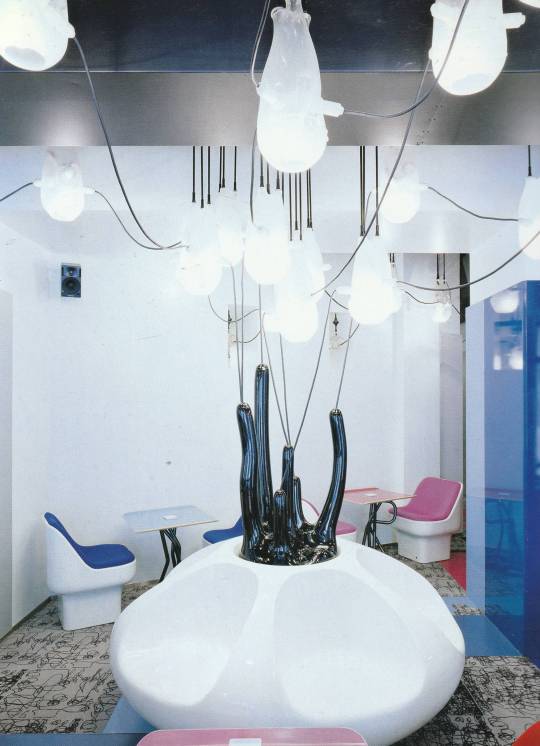
café etienne marcel: paris, france in restaurant design - bethany ryder (2004)
55 notes
·
View notes
Text



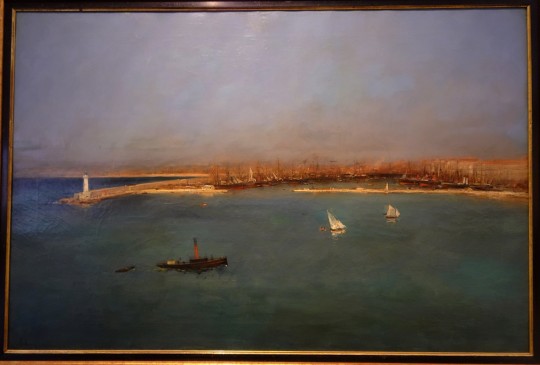




Marseille en août. Le Musée Regards de Provence (anciennes consignes sanitaires à l'architecture moderniste) présentait deux expos.
Celle-ci, "Marseille au cœur maritime" montrait quelques pièces de l'ancien Musée de la Marine de Palais de la Bourse, scandaleusement disparu...
Albert Boussion - "Débarquement des blés"
Marcel Poggioli - "Le Port au XXe siècle"
Frédéric Roux - "Bateaux pêcheurs en rade de Marseille"
Etienne Cornellier - "Entrée du Bassin de la Joliette"
Joseph Garibaldi - calendrier marseillais 1893, "Le Quai de la Major"
Alfred Casile - "Après la pluie, les terrains vagues du Lazaret"
Albert Boussion - "Quais de Marseille"
David Dellepiane - calendrier Moullot 1912
#marseille#musée regards de provence#regards de provence#marseille au coeur maritime#musée de la marine#albert boussion#joliette#marcel poggioli#frédéric roux#étienne cornellier#joseph garibaldi#calendrier#quai de la major#cathédrale de la major#la major#alfred casile#lazaret#david dellepiane
6 notes
·
View notes
Text
In honor of Black History Month, here are 10 Black Americans who were pioneers of their time. (I apologize that this post is late. I’ve been preoccupied with midterm exams)
Eugene Bullard (1895 - 1961)
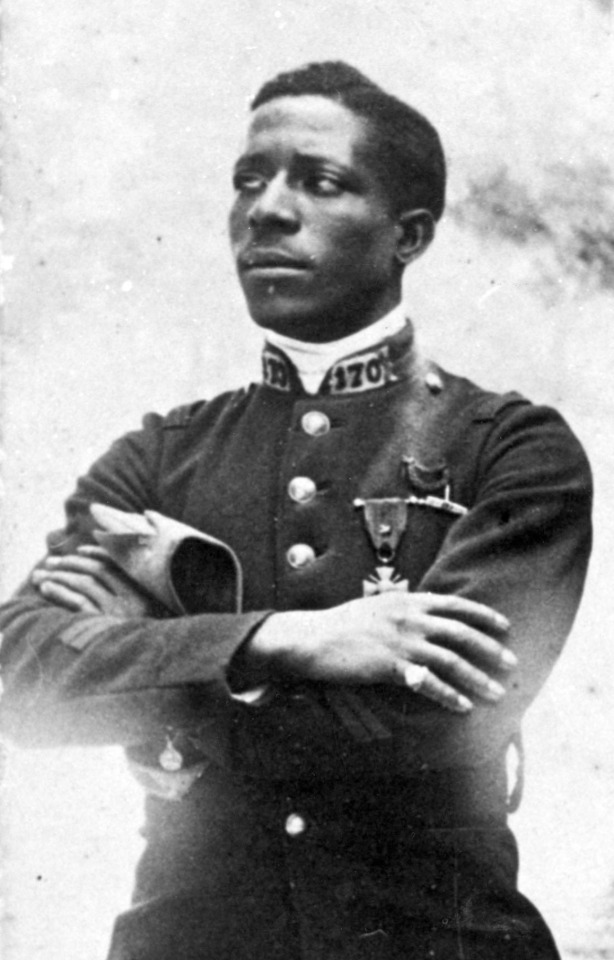
Eugene Bullard was one of the first African American military pilots in the world. Originally from Georgia, Bullard had run away from home when he was 11 and wondered around the state for six years with a clan of gypsies before stowing away on a German cargo ship in 1912. He ended up in Aberdeen, Scotland and eventually ended up in London, where he worked as a boxer and performer for an entertainment troupe. He traveled to Paris for a boxing match and eventually settled there permanently. When World War 1 began in 1914, Bullard joined the French Foreign Legion, where he saw combat at the Somme, Champaign, and Verdun. After being injured during the Battle of Verdun, he was sent to Lyon to recuperate. After recovering in 1916 he joined the French Air Service as a machine gunner. He obtained his pilot's license in 1917. He flew several missions during the war and claimed two victories over German planes. He applied to join the American Air Corps after the United States entered the war in 1917 but was rejected because of his race. Bullard returned to the French Air Service but was removed after an apparent conflict with a French officer. He remained in the military until 1919. He returned to Paris where he worked a nightclub, operated his own nightclub and gym, and married Marcelle de Straumann. After Germany invaded France in 1940, he volunteered to fight again, but was injured during the defense of Orleans. He escaped to Spain and later returned to the United States, settling in Harlem, New York City. In 1949, he was working as a security guard at concert hosted by Paul Robeson. Riots broke out where a racist mob and police officers beat concert goers, including Bullard. He eventually died of Stomach Cancer in 1961.
Bullard received many honors from France. In 1954, the French government invited Bullard to Paris to be one of the three men chosen to rekindle the everlasting flame at the Tomb of the Unkown Soldier under the Arc de Triomphe. In 1959, he was made a Knight of the National Order of the Legion of Honor. He also received the Military Medal, an award given for courageous acts and the third highest award in France. After his death, he also received honors from the United States. He was posthumously commissioned as a Second Lieutenant in the United States Air Force in 1994. He was inducted into the Georgia Aviation Hall of Fame in 1989 and the National Aviation Hall of Fame in 2022. The Museum of Aviation in Warner Robbins, Georgia erected a statute in honor of Bullard.
Ruby Bridges (1954 - )

Ruby Bridges hadn't even been born yet when, in 1954, the United States Supreme Court made a landmark ruling in the Brown vs. Board of Education case that declared that desegregation in public schools was unconstitutional. This decision caused protests and celebrations all across the South, including New Orleans, Louisiana. In 1960, when Ruby was 6 years old, U.S. Circuit Court Judge ruled that schools in New Orleans must begin desegregation. Ruby was one of four 6-year-old girls (the others being Lenona Tate, Tessie Provost, and Gail Etienne) selected by the NAACP to participate in the integration. Tate, Provost, and Etienne enrolled at McDonogh 19 Elementary School, while Bridges enrolled at William Frantz Elementary School. All four faced death threats, racial slurs, and taunts. After a race riot broke out at Parish School Board meeting, U.S. Marshalls were called in to escort the girls to and from school.
Since the tumultuous period, Bridges has become a symbol of the Civil Rights Movement. She has been the subject of Songs, documentaries, movies, and 1964 Norman Rockwell painting "The Problem We All Live With". She is currently the Chair of the Ruby Bridges Foundation. She has also received numerous accolades over her life including the Presidential Citizens Medal by President Clinton in 2001, being honored as a "Hero Against Racism" by the Anti-Defamation League in 2006 and being inducted in the National Women's Hall of Fame in 2024.
Bessie Coleman (1892 - 1926)

Bessie Coleman was born the tenth child out of thirteen to a family of sharecroppers in Texas. She walked four miles each day to attend a segregated school where she loved reading and established herself as an exceptional math student. Every harvest season she helped her family harvest cotton. When was turned eighteen years old, she enrolled at the Oklahoma Colored Agricultural and Normal University in Langston, Oklahoma (known today as Langston University). She only completed one term before running out of funds and returning home. In 1915, she moved to Chicago to live with brothers where she worked as a manicurist at a barbershop, where she heard flying stories of pilots returning from their service in World War 1. She took a second job as a restaurant manager to save money in the hopes of becoming a pilot herself, but flight schools in the U.S. at the time were not accepting women nor black people. As such, she was encouraged to study abroad by Robert Abbott, publisher of the African American newspaper 'The Chicago Defender'. To do this she received financial backing from the defender and banker Jesse Binga (founder of the first black owned bank in Chicago).
In 1920, she traveled to France to earn her license. She trained on a Nieuport 14 Biplane. In 1921, she received her pilots license, becoming the first black woman (and first black person in general) to receive a license from the Fédération Aéronautique Internationale. She returned to the United States in September becoming a media sensation. She made a living performing in air shows as a stunt flier. She met with community activists and spoke before crowds about perusing aviation as a profession and the goals of black people in the United States. Unfortunately, she was killed in 1926, when the plane she was flying in lost control and threw her out at 2,000ft. Though she never established her own flight school, her ambitions inspired many other black aviators to this very day.
Katherine Johnson (1918 - 2020)
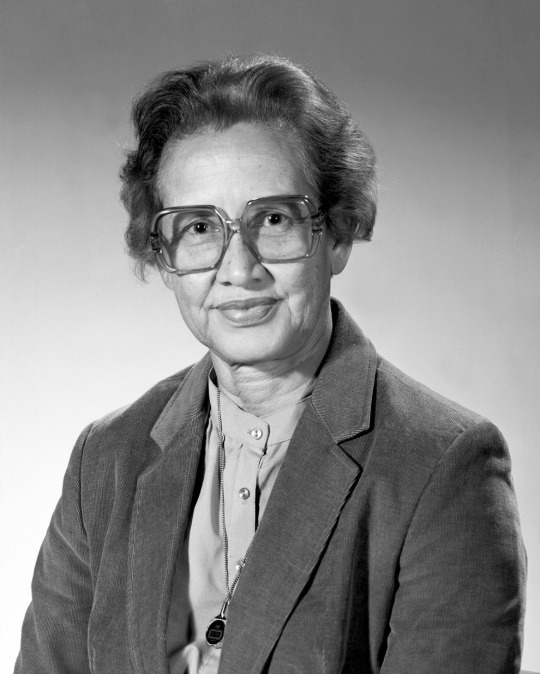
Katherine Johnson was one of the first black to be employed as a scientist at the National Aeronautics and Space Administration. Born in White Sulpher Springs, West Virginia, she was the youngest of four children. Her mother was a teacher, and her father was a lumberjack, farmer, and handyman. From an early age she displayed strong mathematical abilities, so her parents enrolled her in high school in Institute since their home county didn't school for African Americans passed the 8th grade. After graduating high school, she enrolled at West Virginia State College, where took every mathematics course offered (new classes were even added just for her). She graduated 'summa cum laude' in 1937 and took a teaching job Marion, Virginia.
In 1938, the Supreme Court ruled that states that provide higher education for white students must provide it for black students as well. As a result of this, Johnson was selected along with two men to become the first black students to be enrolled at the West Virginia University Graduate School in 1939. However, she left the program to start a family with her husband James Goble. The couple had three daughters: Joylette, Katherine, and Constance.
At a family gathering in 1952, a relative informed her that the National Advisory Committee for Aeronautics (NACA, the precursor to NASA) was hiring mathematicians and that the Langley Research Center was hiring Black applicants as well as white. Johnson took a job at the agency in 1953. She spent 33 years with NACA and NASA, where she earned a reputation as a human computer for mastering complex mathematical calculations and helping pioneer the use of electronic computers. She worked at topics including gust alleviation, flight trajectories, and launch windows. Her work was instrumental to the Apollo Missions during the Cold War 'Space Race'. For her work she was awarded the Presidential Medal of Freedom in 2015, the Silver Snoopy Award and a NASA Group Achievement Award in 2016, and the Congressional Gold Medal in 2019. She was the one of the subjects of the 2016 film Hidden Figures, and she was posthumously inducted into the National Womens Hall of Fame in 2021.
Shirley Chisholm (1924 - 2005)

Shirley Chisholm was the first black woman to be elected to the United States Congress. She was born in Brooklyn to working class parents. Since her mother face difficulty working and raising her children, Shirley and her three younger sisters were to live with their grandmother in Barbados. She said about her grandmother "Granny gave me strength, dignity, and love. I learned from an early age that I was somebody. I didn't need the black revolution to teach me that". She returned to the United States in 1934 and in 1939, began attending the integrated Girl's High School in Brooklyn. She did so well academically, she served as the Vice President of the Junior Arista Honor Society. She attended Brooklyn College where she majored in sociology and graduated in 1946. She married her husband Conrad in 1949. After suffering two miscarriages, the couple learned they could not have children. She worked as a teacher's aide from 1946 to 1953, during which she went on to obtain her master's degree in childhood education from Columbia University in 1951. She soon became an authority on childhood education and child welfare as a consultant for the Division of Day Care in New York City's Bureau of Child Welfare.
She entered politics when she joined the effort to elect Lewis Flagg Jr. to the bench as the first black judge in Brooklyn. The election group became known as the Bedford–Stuyvesant Political League (BSPL), which pushed candidates that supported civil rights and advocated for expanding opportunities in Brooklyn. After leaving the BSPL she worked with a number of different political groups including the League of Women Voters, the National Association for the Advancement of Colored People (NAACP), the Urban League, and the Democratic Party Club in Bedford-Stuyvesant, Brooklyn.
In 1964, Chisholm decided to run for the New York State Assembly after the present holder, Thomas R. Jones, was appointed to the New York City Civil Court. Despite resistance because she was a woman, she appealed to women voters and won the Democratic primary in June. She was elected in December serving in the assembly from 1965 to 1968, where she championed several pieces of legislation including expanding unemployment benefits and sponsoring the introduction of the SEEK program which helped disadvantaged kids enter college. In 1968 Chisholm ran for the United States House of Representatives for New Yorks 12th District, which had recently been redrawn to incorporate the Bedford-Stuyvesant neighborhood. She ran with the slogan "unbought and unbossed" and won the district with a nearly 2 to 1 margin over her opponent, becoming the first black woman ever elected to Congress. She served on a number of different committees during her career, including the Agriculture, Veterans, and Education and Labor Committees. She worked with Bob Dole to expand the Food Stamps program, played a critical role in the creation of the WIC program, and was a founding member of the Congressional Black Caucus and the National Women's Political Caucus. In 1972, she became the first black candidate for a major-party nomination for President of the United States and the first woman to run for the Democratic Party's presidential nomination, though she ultimately lost the nomination. She retired from politics in 1983, after 14 in Congress. She was posthumously awarded the Presidential Medal of Freedom in 2015.
Thurgood Marshall (1908 - 1993)

Thurgood Marshall was a lawyer and jurist who served as the black justice of the United States Supreme Court. Marshall was originally from Baltimore, Maryland, where graduated from high school with honors in 1925 and then attended Lincoln University in Pennsylvania where he graduated with honors in 1930 with a bachelor's degree in American literature and philosophy. While at Lincoln, he led the schools debate team to numerous victories. He attended Howard University Law School in Washington, D.C. because he couldn't attend the all-white University of Maryland Law School. While at Howard, he was mentored by NAACP first special counsel and Law School Dean George Hamilton Houston. He graduated first in class in 1933. He joined Houston as his assistant at the NAACP in 1935, where they worked together on the landmark case Missouri ex rel. Gaines vs. Canada, which ruled that any state which provides a school to white students had to provide in-state education to black students as well. After Houston returned to Washington, Marshall took over his position as special counsel to the NAACP and also became director-counsel of the NAACP Legal Defense and Educational Fund Inc.
During his career he argued 32 civil rights before the Supreme Court, winning 29 of them. Many of them were landmark cases including Smith vs. Allwright (which ruled that primary elections must be open to voters of all races), Morgan vs. Virginia (which ruled that a state law enforcing the segregation of interstate buses was unconstitutional), Shelley vs. Kramer (which ruled that racially restrictive housing covenants cannot be legally enforced), and Brown vs. Board of Education (which ruled that state laws requiring segregation in schools was unconstitutional).
In 1961, President John F. Kennedy appointed him as a judge on the United States Court of Appeals for the Second Circuit in order for Kennedy to demonstrate his commitment to the interests of black Americans. He took the oath after numerous delays by southern Senators. Marshall authored 98 majority opinions while on the bench. He was nominated as the United States Solicitor General by President Lyndon B. Johnson in 1965, where he won fourteen of the nineteen Supreme Court cases he argued. In 1967, Johnson nominated Marshall to be a Supreme Court Justice after Justice Tom C. Cark resigned. He took the Oath of Office on October 2. Marshall remained on the Court for 24 years until his retirement in 1991. A staunch liberal, he often dissented from the court as the liberal majority vanished and the court became more conservative. During his tenure he advocated for equal rights for minorities, opposed the death penalty, and supported abortion rights.
Jesse Owens (1913 - 1980)

Jesse Owens was an American track and field athlete who won four gold medals at the 1936 Summer Olympic Games. Owens was born the youngest of ten children in Oakville, Alabama. In 1922, his family moved to Ohio during the great migration in search of better opportunities. As a child, he developed a passion for running, which was encouraged by his middle school track coach Charles Riley. It was in middle school where he met Minnie Solomon. They married in 1935 and had three daughters: Gloria in 1932, Marlene in 1937, and Beverly in 1940. He first came to national attention while attending high school where he equaled the world record of 9.4 seconds in the 100 yards dash and long-jumped 24 feet 91⁄2 inches at the 1933 National High School Championship in Chicago. While a student at Ohio State University, Owens won a record eight NCAA championships. Notably in 1935, he set three world records and tied a fourth during the Big Ten Conference track meet in Ann Arbor. He equaled the world record of 9.4 seconds in the 100-yard dash and set records for the long jump at 26 feet 81⁄4 inches, the 220-yard sprint at 20.3 seconds, and the 220-yard low hurdles at 22.6 seconds, which cemented him in track and field history.
In 1936, in despite of his apprehension, he was selected to compete in the Summer Olympics in Berlin, Germany. At the time, Germany was under the iron grip of the Nazi regime led by Adolf Hitler. Hitler saw the games as an opportunity to promote the Nazi ideals of antisemitism and Aryan supremacy. He believed German athletes would dominate the games. However, he visions went unfulfilled. Over the length of competition Owens won Gold Medals in the 100-meter dash at 10.3 seconds, the long jump at 26 ft 5 inches, the 200-meter sprint at 20.7 seconds, and the 4 x 100-meter sprint relay at 39.8 seconds. On August 1, Hitler shook hands with the German victors only and left the stadium and then skipped all further medal presentations. Despite his victories, racial discrimination in the United States made it difficult for Owens to earn a living, being prohibited from appearing at sporting events and refused commercial sponsorships. He attempted several careers, but all they proved fruitless. He hit rock bottom in 1966, when he was prosecuted for tax evasion. In 1955, President Dwight D. Eisenhower selected Owens as a Goodwill Ambassador, being sent all around the world to promote physical exercise and tout American freedom and economic opportunity in the developing world, a position held until the 1970s. He also did product endorsement for corporations such as Quaker Oats, Sears and Roebuck, and Johnson & Johnson. He was invited to the 1972 Munich Summer Olympics as a guest of the West German government. He eventually retired and moved to Arizona with his wife. Owens succumbed to Lung Cancer in 1980 at the age of 66 and was buried in Tucson, Arizona. In 1983 he was inducted into the U.S. Olympic Hall of Fame and was posthumously a Congressional Gold Medal in 1990.
Hiram Revels (1827 - 1901)
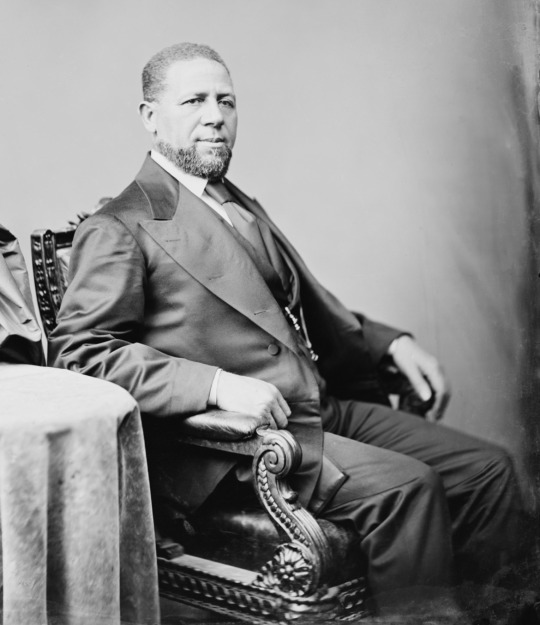
Hiram Revels was the first African-Amercian to serve in the United States Congress. He was born to free black people in Fayetteville, North Carolina. His father was a Baptist preacher. He attended a Quaker seminary in Indiana as a boy and in 1845, was ordained as a minister with the African Methodist Episcopal Church. He traveled throughout the Midwest preaching and acted as a religious teacher. He studied religion at Knox College in Illinois from 1855 to 1857 and then became a minister a Methodist Episcopal Church in Baltimore, Maryland, while also serving as a high school principal. During the Civil War, he enlisted as a Chaplain in the Union Army and helped recruit and organized two black regiments in Maryland and Missouri.
In 1866, Revels was called to be the pastor in Natchez, Mississippi where he settled permanently with his wife and five daughters. In 1868, during the Reconstruction Era, he was elected as an Alderman of Natchez and in 1869, he was elected to represent Adams County in the Mississippi State Legislature. In 1870, Revels was elected to the United States Senate by the state legislature to fill the seat left since before the Civil War. Southern Democrats opposed his seat, stating that the 1857 Dred Scott decision disqualified him on basis if citizenship. He officially became the first black senator on February 25. As a senator, he advocated compromise and moderation, and supported racial equality. He served on both the Committee of Education and Labor and the Committee of the District of Columbia (at the time, Congress administered the district). His professional conduct was greatly admired by fellow congressmen and the Northern press. After his term expired, he became President of Alcorn Agricultural and Mechanical College in Claiborne County, Mississippi (currently Alcorn State University). He served in this post until his retirement in 1882. In 2002, he was listed as one of 100 Greatest African Americans by Molefi Kete Asante.
Henry Johnson (1897 - 1929)

Henry Johnson was an American soldier who was noted for heroic actions during World War One. Originally from North Carolina, he moved to Albany, New York and worked variety of menial jobs before enlisting in the army in 1917, two months after the United States entry into the First World War. The unit he was assigned to, the all-black New York National Guard 15th Infantry Regiment, was mustered into federal service and redesignated as the 369th Infantry Regiment, commonly known as the Harlem Hellfighters. The regiment was assigned to labor service duties while stationed in Europe. The black service members faced discrimination and harassment by white soldiers and even the American headquarters. The American commander loaned the regiment to the French Army. It's believed he did this because white soldiers refused to fight alongside black soldiers. The French enthusiastically welcomed the new troops.
The regiment, Johnson included, was assigned to the Ardennes Forest. While on outpost duty on the night of May 14, 1918, Johnson came under attack by a German raiding party. Using only his bare hands, a bolo knife, his rifle butt, and some grenades, he was able to repel the attackers, killing four of them and preventing the capture of his fellow soldiers, all while suffering 21 wounds. He was given the nickname "Black Death" for his actions and awarded the Croix de guerre by France. However, his actions went unrecognized in the U.S. because of racial discrimination, and he died poor and in obscurity. However, he has since been posthumously given several awards by the military, including the Purple Heart in 1996, the Distinguished Service Cross in 2002, and the Medal of Honor in 2015. In 2023, the U.S. Army base Fort Polk in Louisiana was renamed Fort Johnson in his honor.
Dorothy Height (1912 - 2010)
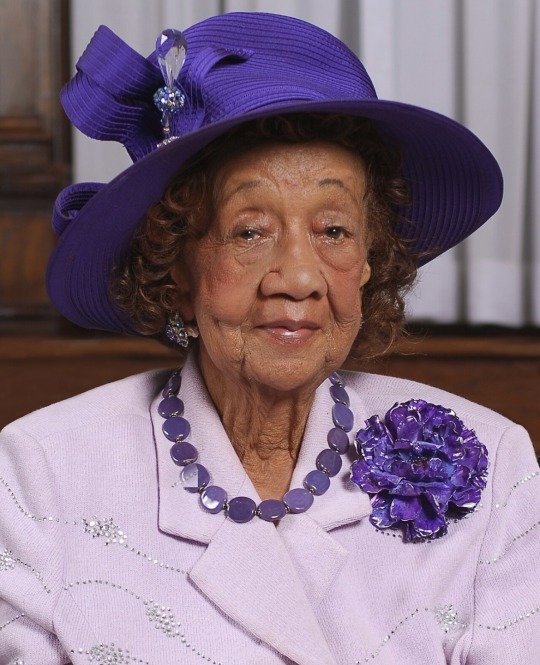
Dorothy Height was an activist for both the Civil Rights and Women's Rights movements. Height was born in Richmond, Virginia and moved to Rankin, Pennsylvania when she was five. Her mother was active in the Pennsylvania Federation of Colored Women's Clubs, and regularly took along Dororthy to meetings, which exposed her to activism from a young age. Height was an enthusiastic participate in Young Women's Christian Association, who was eventually elected as president of the club. She was appalled to learn that her race prevented her from using the YMWA's central branch swimming pool and dedicated much energy to changing the YWCA. While in high school she was active in the anti-lynching movement and won first place and a $1,000 scholarship in a national oratory contest held by the Elks Club. Height graduated from high school in 1929 and was accepted entry in Bernard College at Columbia University but was barred from entering because the school had an unwritten policy of only admitting two black students a year. She instead enrolled at New York University and graduated with a bachelor's degree in 1932 and a master's degree in educational psychology in 1933. She pursued postgraduate work at the New York School of Social Work.
From 1934 to 1937, Height worked for the New York Department of Welfare, a job she credited for teaching her conflict resolution skills. She then took a job as a counselor at the YWCA Harlem Branch. While working there she met civil rights activist Mary McLeod Bethune and First Lady Eleanor Roosevelt at a meeting of the National Council of Negro Women being held at the YWCA office. During this meeting Bethune told her "The freedom gates are half ajar. We must pry them fully open". She dedicated her life to this cause. She also did work with the United Christian Youth Movement, a group that worked to relate faith to real-world problems.
Beginning in 1939, she worked at YWCA offices in New York City and Washington, D.C., specializing in interracial relations. She ran trainings, wrote periodicals, and worked in Public Affairs on race issues. She believed that segregation caused prejudice through estrangement, so after the YWCA adopted in interracial charter in 1946, Height worked to help white members of the organization transcend their apprehension and bring their action in line with what the YWCA principles by running workshops, facilitating meetings, and writing articles. In 1958, she was elected president of the National Council of Negro Women and remained at the post until 1990. While president of the NCNW, she worked alongside civil rights leaders such as Martin Luther King Jr., John Lewis, and Whitney Young. Thanks to her background as an orator, she became a master at acting as the middleman in initiating dialogue between feuding parties. In 1963 she became head of the "Action Program for Integration and Desegregation of Community YWCAs", which was started in response to the growing civil rights movement. In this role she worked to monitor progress in integrating the association. In 1974, she was named to the National Commission for the Protection of Human Subjects of Biomedical and Behavioral Research, which was formed in response to the Tuskegee Syphilis Experiment scandal. She was also a driving force behind the movement to get a statue of Mary McLeod Bethune in Lincoln Park, the first statue of a woman or a black person to be erected on federal land.
She was inducted into the National Women's Hall of Fame in 1993. She was awarded the Presidential Citizen's Medal in 1989, the Presidential Medal of Freedom by President Bill Clinton in 1994, a Congressional Gold Medal by President George H.W. Bush in 2004, and President Barack Obama called Height "the godmother of the civil rights movement and a hero to so many Americans". She died on April 20, 2010, at the age of 98. She was buried at Fort Lincoln Cemetery in Maryland after a funeral at the National Cathedral in Washington D.C. She is considered one of the driving forces of the American Civil Rights Movement.
12 notes
·
View notes
Text
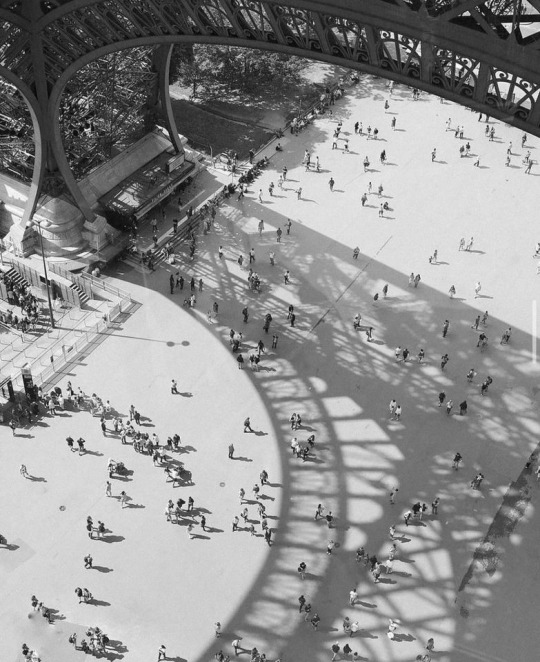
Cyrille Weiner es un fotógrafo francés. Tiene su estudio en 214 Rue Etienne Marcel, 93170 Bagnolet, Francia.
12 notes
·
View notes
Text



























42 ST ETIENNE 2015 La Marandiniere, et la cité moderne de l'arc en ciel ensemble privé de l architecte Pierre Bertholon (COGECOOP créee en 1958) et l'ancien centre commercial bien avant l'actuel Netto rue Marcel Sembat, détruit en 2019 A peu près les mêmes que ceux de Terre et Famille, etc en Yvelines. Très bien faits dupliqués x fois en france dommage qu il n est pas été conservé une architecture typique des 70s
2 notes
·
View notes
Text
Louise "Lou" Ledet [NYTF]

Right on cue, Lou came stalking out of the woods. She crouched by the body, scanning the forest floor. Her hood was pulled back revealing her stern face, shaved head, and eyes that could cut steel. (Knight of Dawn, Chapter 11)
Full Name: Louise Seraphina Ledet
Pronouns: she/they
Title: Queen Consort of State (Louisiana)
Gender: nonbinary (uses female titles)
Sexuality: demisexual
Birthday (Age at start): March 9th, 2163
Parents: Etienne "Marcel" Ledet (deceased), Aurelie Corinne Boudreaux Ledet (deceased)
Siblings: Lisanne Ledet (deceased)
Spouse: Achilles Eloi Gauthier (deceased), ค̡̮̲͚̺̖͖͔͍ͮ๔̡͉̙̝͔͇̌ͥ̃ͅг̷̻̠̆̔เ̶̲͕͎͌ค̠̪̰̱̭̩̐ͩͣ͞ภ̢̬͈ͣͦ ̵̜̦͈̠͇ͨͨ̒͛Շ̤͉̲̹̼̠̎͂̔͢ค̴̙͚͎̭̱̠͓͍̆̌ͫ̐к̰͙̦̘̣̔̎̍́є̇̑̍ͧ͏̗̭̠๏͍̝͉̹̼̮́͝ ̃̓͏̱̝͕๒̦͔̺̮͆̈́͒͋͠є̧͍͎͚̣̟͉̗ͥ͐̉ͅг̢̝̥̙̱͈̇ﻮ̧̖̗͕̽̂̌̚ͅє̨͙̙̣͓̘͕̻̑г͕̪̱̭ͪ̊ͭ͘๏̧̙͈͇̻͔͍̬ͪภ̙̣ͨ͗̽͢
Notable physical features: shaved or half-shaved head (depending on the book), scars on her face, usually wearing tactical gear
Personality: unstable, bitter, paranoid, impulsive, odd, shrewd, quiet


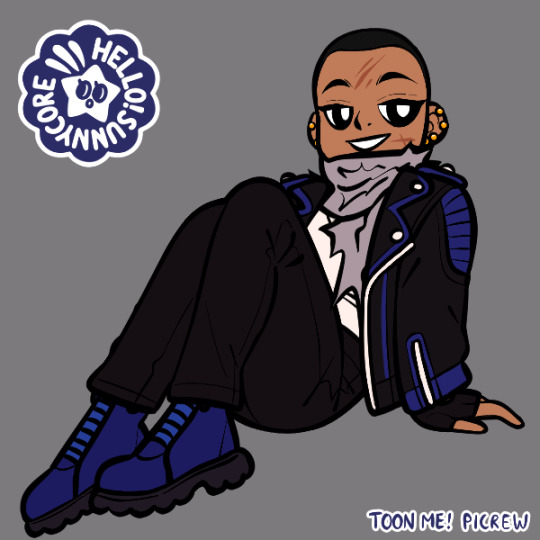
Extended Introduction
(CW for Child Marriage)
Louise Seraphina Ledet (Gauthier) is the intriguing outsider who lives not too far from the Perimeter. They are a mother figure to Lennox at their best, and an absolute nightmare to deal with at their worst. Lou is highly unstable and prone to acting violently, even towards those she cares about.
Lou was the second of two daughters born in the New Orleans Parish Zone of Louisiana to influential entrepreneurs who controlled much of the food supply in the old Ninth Ward. Lisanne, her older sister, married the Prince of the New Orleans Parish at the time, Achilles Gauthier. Soon after, the previous King of State died, and Achilles assumed the role, making a pregnant Lisanne the Queen Consort of State. Lisanne died in childbirth, and King Gauthier, inflated with egotistical power, blamed the Ledet family and demanded to marry the then-15 year old Louise Ledet. Marcel and Aurelie allowed for this to happen.
Less than six months after their marriage, King Gauthier bled to death after having his genitals removed, and Louise Ledet fled the state. Nowadays, Lou can be found all over the states of Louisiana, Mississippi, Alabama, and most often, Georgia. They have a scattering of safe homes across the southeast and continue to rule the state of Louisiana from their odd isolation. Lou rarely returns home.
NYTF WIP PAGE
Tag List (reply or dm to be added or removed; I pulled from the old tag list + the call post):@author-a-holmes, @soul-write @flowerprose @ceph-the-ghost-writer @theglitchywriterboi @when-wax-wings-melt @thechaoticflowergarden @lyralit @penspiration-writing @samatedeansbroccoli @charlesjosephwrites @italiangothicwriteblr @thetruearchmagos @pineapple-lover-boy @unilightwrites @sanguine-arena @bardic-tales @joshuaorrizonte @blind-the-winds @circa-specturgia @hymnonlips @aloeverawrites @the-stray-storyteller @writeblrsupport @starlit-skys @kyuponstories @guessillcallitart @magic-is-something-we-create @talesofsorrowandofruin @writingonmymind @imslowlydisintegrating @worldsfromhoney
#character introduction#writeblr#writing#character development#oc#oc intro#writeblr stuff#athenswrites#nytf#louise ledet
7 notes
·
View notes
Text

"Conservatrice au sens le plus profond, la révolte paysanne l’est assurément. Mais c’est dans la radicalité même de son conservatisme qu’il faut lire ce qu’elle véhicule d’aspiration à la liberté. Que veut-elle conserver ? Que se soucie-t-elle de préserver ? L’espace libre, la sphère autonome de la communauté familiale et villageoise, que de façon remarquablement universelle les anciennes formes de domination étatique ont toujours laissé subsister et que seul l’Etat occidental moderne s’est employé à détruire. De la Chine aux Andes, les anciens empires ont certes engendré des machines étatiques autrement plus écrasantes que celles sécrétées par les monarchies européennes du XVIe siècle. Mais cet appareil bureaucratique qui s’édifie à la tête de la société laisse à la base perdurer un monde à l’écart de l’Etat et monde même d’avant l’Etat par beaucoup de ses traits. L’ambition de l’Etat moderne, tel qu’il trouve précisément ses assises stables dans l’Europe du XVIe siècle, est tout autre. Non pas contrôler du dessus et à distance la société pour en extraire le surplus économique mais pénétrer littéralement la société, s’introduire dans ses articulations les plus fines, se rendre maître de ses rouages les plus intimes. Réglementer, codifier, redéfinir, changer, moderniser. "Civiliser", diront les grands commis éclairés et les serviteurs zélés. Briser donc cette base ou ce noyau le plus archaïque où se conservent d’antiques modes de pensée, des gestes millénaires et surtout un gouvernement de la petite communauté continuant à conjurer au sein d’elle-même par la tradition la différence de ceux qui commandent et de ceux qui obéissent. L’Etat partout, l’autorité partout proche ; même là où subsistait un tout petit peu d’une très ancienne liberté : tel se dessine l’horizon social dès l’instant où s’affirme pleinement le projet étatique […] Le prétexte immédiat de la révolte peut n’être que fiscal. Un examen plus approfondi révèle déjà derrière la défense des intérêts la haine d’une innovation signifiant toujours surcroit de pression sur le "populaire" – la haine aussi, en la personne du gabeleur, de l’intrus rendant sensible la volonté d’inquisition d’un pouvoir jusque-là lointain. Au-delà du poids de l’impôt et de la pression administrative, c’est le nouveau qu’on redoute, le nouveau d’un Etat dont on pressent qu’il ne va cesser de produire du nouveau."
Miguel Abensour et Marcel Gauchet, « Les leçons de la servitude et leur destin », in Etienne de La Boetie, Le discours de la servitude volontaire, 2002.
5 notes
·
View notes
Text
Os Temas de Outlander por Diana Gabaldon

Os textos que você vai ler foram escritos por Diana Gabaldon, aonde ela comenta sobre cada um de seus livros e o significado de cada um deles. Estes textos podem ser lidos em inglês no seu famoso Compendium, o The Outlandish Companion. A tradução foi feita pela equipe Outlander Brasil.
Os textos abaixo contém spoilers. Se você não gosta de spoilers, veja apenas dos livros que você já leu.

A viajante do tempo - Amor
Enquanto meus livros são frequentemente classificados como (por pessoas sem saber do que chamá-los) romances românticos, eles não são. Entretanto, A viajante do tempo é, de fato, o único que tem a estrutura necessária para ainda passar como romance romântico. Isto é, é uma história de um namoro; seu mecanismo central preocupa-se com a união de duas pessoas em uma (teoricamente) permanente união monogâmica. Além disso, contudo, explora a natureza do amor sobre uma série de níveis e em uma variedade de contextos.
Nós temos o conflito de Claire sobre (verdadeiramente) amar dois homens. Temos o amor de Jamie por seu pai, sua irmã, e seu lar, e o amor de Murtagh por seu afilhado. Nós temos o amor profundamente conflituoso entre os irmãos MacKenzie. Temos o amor dos membros do clã um pelo outro, seu Laird e seu lar. Temos as emoções muito complicadas do Capitão Jack Randall, embora se alguma delas constituem amor, ou meramente obsessão, é um assunto para o leitor decidir. E temos o Amor Divino, no qual Claire mais ou menos tropeça em um ato de desespero. Mas quase todo relacionamento no livro descansa no amor e a história inteira como uma prova do poder do amor.

A Libélula no Âmbar - Casamento
Este livro lida, principalmente, com o desenvolvimento de um casamento específico- o de Claire e Jamie- mas ao longo do caminho se observa vários outros relacionamentos e combinações que exploram o conceito. Temos o casamento arranjado de Mary Hawkins e o idoso e verruguento Visconde Marigny. Temos os casamentos de classe e conveniência sem amor, porém pragmáticos vistos na Corte Francesa e os casos eventuais e egoístas que contrastam tão fortemente com o senso de compromisso e abnegação no coração de um bom casamento. Mais tarde nós vemos o amor condenado entre Mary e Alex Randall, e o casamento pragmático entre ela e Jack Randall (baseado no amor de Jack por seu irmão, ao invés de por Mary). Vemos a culpa de um casamento rompido e remendado na recomeço das relações de Claire com Frank e a paz de um casamento duradouro, profundamente comprometido entre Jenny e Ian em Lallybroch, e apreciamos as várias ameaças que há nesses vínculos sociais e como as pessoas sustentam um casamento, ou não.

O Resgate no Mar - Identidade
O Resgate no Mar tem muita aventura, mudança de tempos e lugares, busca de destino e assim por diante, mas o tema basilar é a busca de uma pessoa por identidade e como se definir, aos seus próprios olhos, ou nos dos outros, ou nos da sociedade no geral. Pelo casamento, pela carreira, pela vocação- ou pelo reconhecimento da sua própria essência de ser. Você vê isso organizado mais visivelmente (claro) na história de Claire e Jamie, primeiro conforme ela busca o marido que ela perdeu e por quem anseia e então conforme eles buscam por um desembarque seguro e um lugar que possam sobreviver juntos.
A metáfora contínua encontrando seus nomes: Jamie tem cinco para escolher, mais um título mais vários apelidos e ele vive sob uma variedade de noms de guerre (frequentemente baseados literalmente de guerre) ao longo do livro, em resposta a sua mudança de funções e de quem está atrás dele no momento. Claire, claro, saiu de Beauchamp, para Randall, para Fraser, para Randall e agora está prestes a ser novamente Claire Fraser, ou será Sra. Malcolm? Ou talvez Madame Etienne Marcel de Provac Alexandre? (Simbolizando a ligação do seu destino com o de Jamie, sim?). Como Jamie conta a Claire no meio do livro,
“—Durante tantos anos —ele disse— por tanto tempo, eu fui tantas coisas, tantos homens diferentes. — Senti que ele engolia em seco e ele remexeu-se um pouco, o linho de seu camisão farfalhando de goma. —Fui tio para os filhos de Jenny e irmão para ela e Ian. ‘Milorde’ para Fergus e ‘Senhor’ para os meus colonos. ‘Mac Dubh’ para os homens de Ardsmuir e ‘MacKenzie’ para os outros empregados em Helwater. Depois, ‘Malcolm, o mestre-impressor’ e ‘Jamie Roy’ nas docas. — A mão acariciou meus cabelos, devagar, com um som sussurrante, como o vento do lado de fora. —Mas aqui —ele disse, tão baixinho que mal podia ouvi-lo —aqui no escuro, com você... eu não tenho nenhum nome.” Eles dois adotam, descartam e adaptam funções conforme vão de um bordel em Edimburgo, a Lallybroch, ao Caribe, e por último lançados à praia por um furacão, para a América. Lá, despojados de tudo, exceto um do outro, Jamie finalmente recupera e reapresenta sua identidade, quando ele se apresenta a um salvador: 'Meu nome é Jamie Fraser... E essa é Claire... Minha esposa.”

Os Tambores de Outono - Família
Se A Libélula no Âmbar lida com o estabelecimento e crescimento de um casamento, Tambores faz o mesmo com o conceito de família e sua importância na vida de uma pessoa. Uma das maiores noções, desenvolvida ao longo dos livros, é que uma família não consiste apenas de pessoas que compartilham DNA, nem uma família deixa de ser importante, se seus membros estão separados, ou mortos. A família de Claire e Jamie, conforme eles estabelecem-se na Carolina do Norte consiste em Fergus e Marsali, o filho deles, Germain e o sobrinho de Jamie, Ian, assim como Brianna, a filha que Jamie nunca viu.
Quanto a essa filha, seu choque ao saber da verdade de sua paternidade a conduz a achar sua família e arriscar tudo para salvá-la, enquanto Roger MacKenzie Wakefield (nascido Mackenzie, mas adotado por seu tio-avô) arrisca tudo por causa dela, e torna-se sua família, também, juntamente com seu filho, Jeremiah (que pode ou não ser de Roger, mas o qual Roger reivindica firmemente como seu). Qaundo Brianna escreve no seu bilhete para Roger, anexo com a prataria da sua família, fotos e recordações: “Todo mundo precisa de uma história... Esta é a minha.”

A Cruz de Fogo - Comunidade
A Cruz de Fogo continua o senso de “construção” dos livros, do namoro, ao casamento, à família e agora à formação de uma comunidade, conforme Jamie reivindica seu destino original como laird e líder, sustentáculo e protetor de uma comunidade. Vimos fazer isso (brevemente) em Lallybroch e então durante os anos depois de Culloden, quando ele liderou os prisioneiros em Ardsmuir, e os manteve (na sua maior parte) sãos e vivos ao forjá-los em uma comunidade. Jamie foi sempre definido (para ele mesmo, assim como para o leitor) pelo seu forte senso de responsabilidade e aqui nós o vemos em pleno funcionamento, conforme ele junta arrendatários para sua terra, Fraser’s Ridge, com a ajuda (e obstáculo ocasional de arrepiar os cabelos) dos viajantes do tempo de sua família.
Assim como em qualquer história que vale a pena, a autodefinição de um protagonista (quer seja uma pessoa ou um grupo) é um processo tanto de descoberta, como de conflito. Pedras no caminho, oposição e perigo são as ferramentas que a natureza usa para esculpir uma personalidade marcante da pedra nativa. E assim nós vemos não apenas a formação da comunidade de Fraser’s Ridge (um paralelo e microcosmo da América emergente), mas a luta individual de Jamie, Claire, Brianna, Roger e outros para se encaixarem no seu ambiente em mudança, e preservar suas próprias identidades e descobrir suas vocações no processo.

Um Sopro de Neve e Cinzas - Lealdade
Estou tentada a dizer que o tema de uma única palavra desse livro é “sobrevivência”, mas os meios pelos quais tantas pessoas sobrevivem às vicissitudes de um mundo girando fora de controle é realmente um tema melhor, eu acho. Nesta instância, nós exploramos a lealdade feroz de Claire e Jamie um com o outro e com sua família. Mas além de lealdade as pessoas, lealdade as ideias e ideais é uma coisa enorme nessa época da História da América e o conflito dessas lealdades é paradoxalmente tanto a causa de fratura social, como dos meios de sobrevivência, quando o mundo está em colapso.
Nós vemos outras formas de lealdade em trabalho, a lealdade da ganância e autoproteção, entre a gangue de Brown e o bando de saqueadores de Hodgepile; a lealdade à tradição e aos líderes entre os Cherokee; a lealdade ao Rei, país e regimento mostrada por John Grey, e a lealdade da amizade, como vemos entre Lord John e Jamie. E, em última análise, nós vemos a lealdade e amor dos pais, que farão qualquer sacrifício para o bem de seus filhos e o futuro.

Ecos do Futuro - Nexo
O ícone na capa da edição americana desse livro é um estrepe, uma arma militar que data à época dos Romanos. O ícone na capa da edição do Reino Unido é um esqueleto de folha, mostrando a superioridade do departamento de arte de Orion em relação aos meus próprios instintos, mas incorporando o mesmo conceito basilar: as ligações complexas e frágeis entre pessoas, períodos e circunstâncias.
O livro segue quatro histórias principais, as quais se conectam de forma maior e menor e, dependendo de qual imagem de capa você prefere, revela a importância e resiliência de tais conexões em tempos de guerra e conflitos pessoais ou mostra as veias subjacentes de nutrição e sustento entre as pessoas que as mantém inteiras apesar dos estresses da passagem do tempo. Como com Um Sopro de Neve e Cinzas, EU considerei um tema alternativo de uma única palavra, neste caso, “mortalidade”. Não morte, como tal, mas uma realização da natureza finita da vida e o que isso faz as pessoas. Esse era um conceito muito mais difícil de pôr em uma capa, entretanto.

Escrito com o sangue do meu coração – Perdão
Se a palavra de Eco era “nexo”, os leitores mais perspicazes estão provavelmente esperando que a de MOBY seja “espaguete”, ou, possivelmente, “polvo”. Entretanto, não é. É “perdão”, tanto a doação deste bálsamo, como a recusa de perdoar e o que a doação e a recusa fazem tanto aos doares, como aos beneficiários em ambos os casos.
Vemos esse conceito em operação entre os personagens principais- particularmente no que diz respeito à reação de William a descoberta de sua verdadeira paternidade e no que diz respeito aos esforços de Claire em lidar com conhecer o homem que a estuprou e sua reação com o que Jamie faz em relação a isso. Mas também o vemos em passagens menos importantes, lidando com personagens incidentais. A Sra. Bradshaw e a escrava Sophronia, por exemplo. A Sra. Bradshaw mostra uma determinação corajosa em ajudar a garota (assim perdoando-a pelo que poderia ser visto por uma mulher inferior como cumplicidade na infidelidade de seu marido), apesar de sua incapacidade (e quem poderia imaginar isso?) de perdoar seu marido e a luta interna aparente que a situação a custa. Rachel perdoa Ian imediatamente acerca de sua confissão que ele fora casado anteriormente e sua admissão do medo que ele poderia não dar a ela, filhos.
Jamie perdoa Claire e, relutantemente, Lord John, por terem dormido um com o outro, enquanto pensavam que ele estivesse morto, mas não consegue perdoar Lord John por confirmar diretamente seu próprio desejo por Jamie.
Claire instantaneamente perdoa Jenny, a cunhada que outrora ela amara profundamente. Jenny enfaticamente não perdoa Hal, o comandante dos homens que machucou sua família e que contribuiu para a morte de seu marido, mas ela aconselha e ajuda Claire, que deve lidar com sua realização que o homem que a estuprou está vivo, ao compartilhar a experiência de sua filha. Buck MacKenzie não consegue se perdoar pelas formas como ele falhou com sua esposa. Roger explicitamente perdoa Buck pelo seu papel em enforcá-lo, mas demonstra o efeito bumerangue do perdão, no qual a sensação da ferida retorna e deve ser lidada outra vez.
Fanny perdoa William e Jamie por não terem sido capazes de salvar Jane, mas você pode claramente ver que eles não perdoam a si mesmos e vão viver com os efeitos de seu fracasso por algum tempo. “Espaguete” é provavelmente o termo certo, realmente...
GABALDON, Diana. The Outlandish Companion. New York: Delacorte Press, 2015. V.2, p. 545-550
4 notes
·
View notes
Text
La féconde rencontre entre Bourdieu et Panofsky
Roger Chartier
Professeur Émérite Au Collège De France
Dans son cours sur Manet, donné au Collège de France en 1999, Pierre Bourdieu (1930-2002) expliquait : « J’ai été un des introducteurs de Panofsky en France (…), je suis même assez vieux pour avoir échangé une correspondance avec Panofsky au sujet de la traduction de ses livres, et j’ai la plus grande admiration pour ce grand historien de l’art. » (Sur Manet. Une révolution symbolique, Seuil, 2013.) Bourdieu rappelait ainsi la publication, en 1967, aux Editions de Minuit, dans la collection « Le sens commun », qu’il avait fondée trois ans plus tôt, du livre d’Erwin Panofsky (1892-1968) Architecture gothique et pensée scolastique, qu’il avait lui-même traduit.
L’historien Etienne Anheim et le sociologue Paul Pasquali ont retrouvé dans les archives de Bourdieu et dans celles de Gerda Panofsky, la veuve de l’historien, les treize lettres échangées entre décembre 1966 et juin 1967, témoignages d’une conversation qui, disent-ils, ne « pouvait qu’être dissymétrique ». A cette date, Bourdieu n’était encore que l’auteur des Héritiers, le livre écrit avec Jean-Claude Passeron (Minuit, 1964), et le coauteur de deux enquêtes publiées dans sa collection : Un art moyen. Essai sur les usages sociaux de la photographie (1965) et L’Amour de l’art. Les musées d’art européens et leur public (1966).
En 1966, Panofsky était membre de l’Institute for Advanced Studies de Princeton (New Jersey). Après avoir été professeur à Hambourg en 1920, il s’était installé définitivement aux Etats-Unis pour fuir le nazisme. Il était l’auteur d’une œuvre immense, écrite d’abord en allemand (Idea, en 1924, et La Perspective comme forme symbolique, en 1927), puis en anglais (Essais d’iconologie, en 1939, et L’Œuvre d’art et ses significations, en 1955). Aucun de ses livres n’avait été traduit en français avant 1967, lorsque furent publiés en même temps le livre de Minuit et les Essais d’iconologie chez Gallimard.
Bourdieu et Panofsky, d’Anheim et Pasquali, associe trois histoires. D’abord, celle d’un livre ou, plutôt, de l’invention d’un livre. En effet, Architecture gothique et pensée scolastique n’existait pas comme tel en anglais. Il associe deux textes : une conférence publiée en 1951, qui donne son titre au livre français, et une introduction à l’édition des œuvres de l’abbé Suger (v. 1080-1151), parue en 1946. Leur réunion, divisée en chapitres, est accompagnée par une postface de trente pages de Bourdieu et par un index où apparaissent des notions absentes du texte original.
Ces transformations et additions, acceptées sans réserve par Panofsky, inscrivent le livre dans une seconde histoire : celle de la notion d’habitus, qui désigne les modes de perception et de classification propres à chaque individu comme une intériorisation mentale des structures sociales. Dans Les Règles de l’art, publié en 1992 (Seuil), Bourdieu écrit : « La notion d’habitus que j’ai introduite à la faveur de la publication en français de deux articles de Panofsky (…) me permettait de rompre avec le paradigme structuraliste sans retomber dans la vieille philosophie du sujet ou de la conscience. » En fait, Panofsky n’emploie pas le mot mais rapporte les principes qui commandent, tout à la fois, l’architecture des cathédrales et le raisonnement scolastique aux mêmes « mental habits » (« habitudes mentales ») produits par le partage des mêmes « habit-forming forces » (« forces d’accoutumance »), les institutions scolaires ou sociales qui inculquent les habitudes : écoles cathédrales, universités et sociabilités intellectuelles partagées.
En utilisant dans sa traduction le terme « habitus », Bourdieu n’inventait pas un concept nouveau. « Habitus » avait une longue histoire, depuis Aristote et la scolastique jusqu’à Etienne Gilson ou Marcel Mauss. Mais, en prenant appui sur Panofsky et en allant « bien au-delà de la lettre », Bourdieu forgeait et légitimait une notion essentielle de sa sociologie.
Bourdieu et Panofsky propose une troisième histoire : celle d’un moment intellectuel caractérisé par une internationalisation des échanges et par la confrontation entre les approches structuralistes et formalistes et les sciences humaines préoccupées par les contraintes sociales et les discontinuités historiques. C’est en héritiers d’une telle perspective qu’Anheim et Pasquali situent leur projet d’« archéologie intellectuelle ». Ils démontent avec minutie et subtilité les opérations éditoriales et les mutations conceptuelles qui « ont fait d’un ouvrage marginal au sein de l’œuvre de l’historien d’art un “classique” des sciences sociales ».
Bourdieu et Panofsky. Essai d’archéologie intellectuelle, suivi de leur correspondance inédite, d’Etienne Anheim et Paul Pasquali,
Minuit, « Le sens commun », 286 p., 23 €, numérique 17 €.
0 notes